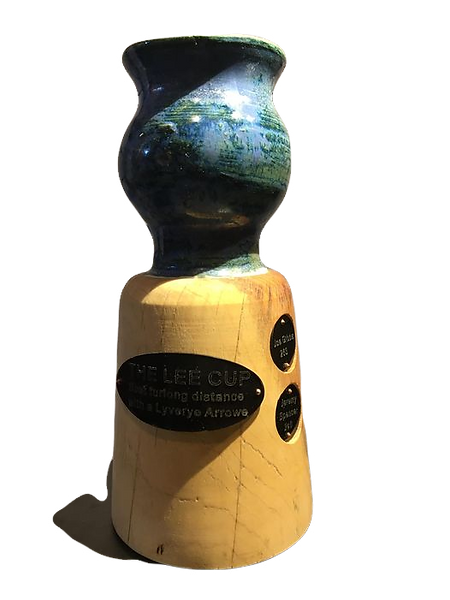Historical Events
Historical Events
Historical Events
Historical Events

Croeso/Welcome Warbow Wales is the home of the Welsh medieval longbow. We shoot the bow of Medieval Wales in historical archery events. Shoots are free and open to all competent longbow archers.
The Welsh Warbow
Historical Events

Bowmen shooting at the butts from the Luttrell Psalter circa 1320 – 1340. From the Assize of Arms of 1252, also called the Ordinance of 1252, Henry III obliged every able-bodied man aged 15-60 to arm themselves with bows and arrows.
From the image, it is difficult to extrapolate whether two or three arrows are being shot per end. There are six figures depicted and eight arrows visible. The two archers at the back may have shot or still have arrows tucked into their belts. Certainly no more than three arrows per end and not less than two seem likely.
Notice also the bulbous blunt arrows and nocks and double-looped bowstrings.
C/O the British Library
Shooting at the Buttsale
The tem 'butts' in, an archery context, perhaps derives from from Old French but "aim, goal, end, target" of an arrow, etc. (13c.), which seems to be a fusion of Old French words for "end" (bot) and "aim, goal" (but), both ultimately from Germanic. The latter is from Frankish *but "stump, stock, block," or some other Germanic source (compare Old Norse butr "log of wood"). Certainly, ‘Shooting at the butts’, was the staple medieval practise that honed generations of bowmen’s skill. The butts were the targets for long range shooting and consisted of nothing more complicated than a turfed mound of earth (or better still two) set at good distance apart to encourage strong shooting. Around 220 paces, or a furlong, were traditional. As the standard of military archery declined during the Tudor period the authorities were alarmed enough to put measures into place to address it. A 1541 bill decreed that it was forbidden for any man over the age of twenty-four to shoot at a mark less than 220yards in distance, thus necessitating the need for mastery of a heavy longbow.
In the centre of each butt was placed a plated garland at the height of a man’s chest. The best representation of a longbow butt is an illustration in the Luttrell Psalter which was written and illustrated in the years between 1325-35. Every Sunday, after church, and Holy days, thousands of Welshmen would shoot for enjoyment at the butts (and this was reinforced by the royal edict of Edward III who made it obligatory in 1363). This sport was in no small part responsible for elevating our archers to become the undisputed best in Europe. Rather like rugby now, archery was the national obsession and clearly fitted our mindset.
In 1515 Henry VIII, a keen archer and son of Welshman Henry Tudor, amended an earlier statute to ensure this was perpetuated from father to soon.
"bowes and arrowes be bought for chyldren under XVII and above VII yere, by him that has such a chylde in his house, and the Maister maye stoppe it againe of his wages, and after that age he to provideb them himself."
During the Middle Ages one can imagine family (and perhaps regional) shooting styles. Due to globalisation and modern national /international coaching guidelines this is no longer so.
However, the crack Welsh archers (serving in English armies) enemies could not or dare not encourage such activities themselves. The Scots clan based society was not centralised enough to enforce such practise and social order was too unstable to arm train and arm the French ‘Levée en masse’ with such a devastating weapon. Neither nation took to the bow in way the Welsh did. A look at any map of Wales and England will show how shooting at the butts was so wide spread as it has left an indelible mark. Many villages and towns will bear the name of ‘The Butts’ or ‘Butts Lane’ etc with Worcester’s ‘The Butts’ being a particularly famous example. The longbow was the yeoman’s weapon. Perhaps this is one of the reasons our Peasant’s Revolt was more successful then some other nations?
Warbow Wales will hold accuracy records for the following event;
Ends of three arrows shall be shot at butts not less than 200 paces apart. Striking the central garland shall be worth 50 points and a hit to the face of the butt worth 5. An arrow strike through or touching the fabric of the garland shall also be worth 50 points.
Arrows shafts of 3/8ths or thicker are encouraged 'to give great stripe'
(Left) A recreated medieval style archery butt by Brian Lee. (Centre and left) Bbutts can be recreated using straw bales positioned a furlong, or 220 yard, apart. that's an 1/8 of a mile.
Wand shooting: History and Rationale
Historical references to wand shooting are not uncommon. A famous literary example is the unattributed ‘Ballad of Robin Hood and Queen Katherine’, probably committed to paper in the reign of Henry VIII. However, dating the actual story if difficult as many of these ‘gests’ often existed as oral traditions long before being written down. Queen Katherine is allowed to choose an archer to represent her against the King’s champion. Naturally her man is Robin!
Robbin Hood hee led about
Hee shot it underhand: (meaning his bow arm was elevated, necessary for distance shooting)
And Clifton (the King’s champion) with a bearing arrow (one specially designed to fly a long way)
He cleave the willow wand.
In another verse there is a more direct reference to the wand being a distant target.
‘Ful fifteen score your mark shall be, (300 yards or paces)
Ful fifteen score shall stand;
‘I‘le lay my bow,’ said Clifton then,
‘I’le cleave the willow wand’ (Hits were recorded but a split wand was the objective)
According to renowned longbow expert, Hugh Soar, the wand was likely to have been a substantial stave of some 4” in width. However good the archer, at the extreme range the gest suggests is an exaggeration. Hitting a 30” modern clout target, at 120 yards less than Robin’s shot, is not a very common feat.
(Below) A powerful archer cleaving a 2" hazel wand. The garland is positioned at chest height.

The Warbow Wales Man-Sized Target: Rationale
During battles both man and horse were usually the targets. The horrific wounds of unfortunate soldiers killed during the Battle of Towton, Britain’s bloodiest battle, attest to the power of the warbow. Exhumed from mass grave pits the skeletons show the penetrating force of that man-stopping missile, the livery arrow, in graphic detail. No nation was more skilled at the grim trade of martial archery than the Welsh. In order to quantify the accuracy of mid range target shooting like that of the precursor to the hand-to-hand mêlée, the arrowstorm. Although not a historical form of mark, the Man-sized target simulates the approximate surface area of a moving man-at-arms, an arrangement of hay bales will be used to create an area of 2' x 6'
.

The Warbow Wales Man-sized Target can be easily formed from straw bales. This allows for a universal and standard target for warbow archers everywhere.
(Left) The Warbow Wales Man-Sized target at 100 yards
According to John M. Kistler, in his book ‘Animals in the Military’ A knight mounted on a destrier would close with the archer’s at 25 mph and would reach them in just over 6 1/2 second from 80 yards and a 6 mph man-at-arms on foot in 34 seconds. If the archer’s nerves held there may perhaps time for approximately 3 arrows at the latter and just time to pick up mêlée weapons in the former. This is assuming the archer was unprotected but stakes, pit-falls or caltrops. Although not under this sort of pressure, the man-sized target provides hard data about standard of accuracy for sustained shooting at mid range.
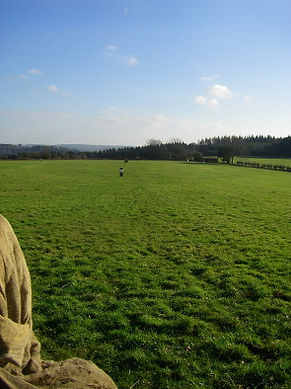
Warbow Wales will hold accuracy records for the following event;
The Man-sized targets shall be divided into 3 scoring zones, the legs for 1 point, torso for 2 points and head for 3 points. Three arrows will be shot from an undisclosed distance of between 80-100 paces and results recorded.
All new records will be posted on the Warbow Wales website after a shoot. This will record outstandingly accurate and strong shooting and form a benchmark database as to standards of accuracy achievable with a heavy longbow.
Roving Marks
Roving is an informal event whereby marks at unknown distances, commonly flags, are set out on open and often rolling ground. These are shot from one to another at high trajectory shooting. The scoring is according to how close the arrows are to the mark up to two bows length away.
Whilst Warbow Wales will hold roves no records will be held for this event and scoring will e via 'the upshot' whereby the best arrow takes the point. Hence, our expression "What's the upshot"

Field Shooting
Warbow Wales will hold field shooting events (with 3D foam animals at unknown distances often in woodland). It is a good substitute for the medieval practise of bow hunting from stable stand. FARAS' Simon Stanley has long been the premier exponent of field shooting with a high draw-weight warbow. In Britain, bow hunting was made illegal in the 1960s.
A contemporary treatise on medieval bow hunting is Livre de la chasse by Gaston Phébus written between 1387 and 1389
The scoring for this event is already well codified GNAS and will be used.
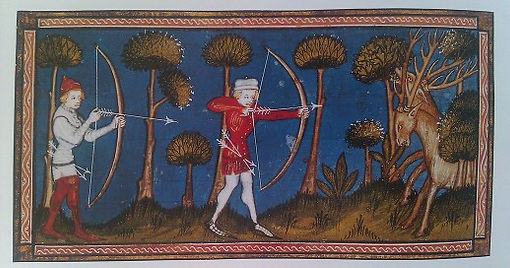
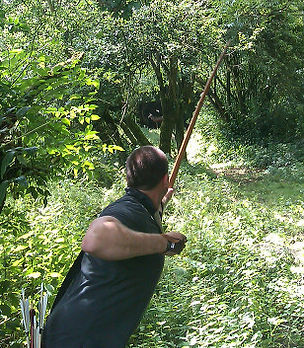
Flight shooting: History and rationale
Period selfbows with natural strings, both from material available to the medieval Welsh bowyer and stringer for flight records
‘Strong shooting’ has always been prized for military archers’. The ability to project a man stopping missile, at a high velocity, is essential in order to penetrate armour and inflict grievous wounds upon the enemy. Sunday shooting at the butts, always over a good distance, was nothing short of training for the battle field. In the days before the chronograph the only way to see if military effectiveness was reached was to shoot for distance as it is inseparably linked to arrow speed. The Welsh way of ‘shooting in the bow’ was a technique employed to use the strength of the whole body to draw the bow to the ear and beyond. This stored a massive amount of energy that an efficient bow would transfer to the deadly projectile. Juxtapose the static style of a modern Olympic archer drawing 45lbs with the dynamic draw of African Hadza Bushman with his 100lb elephant hunting bow and the two are worlds apart and on so many levels. The medieval Welsh style was more akin to the latter.
The venerable Bishop Hugh Latimer (1487 –1555) gave a sermon about the decline of morals linked and subsequent decline in military archery.
"In my time my poor father was as diligent to, teach me to shoot, as to learn me any other thing; and so I think other men did their children, he taught me how to draw, how to lay my body in my bow, and not to draw with strength of arms, as other nations do, but with strength of the body: I had my bows bought me, according to my age and strength; as I increased in them, so my bows were made bigger and bigger, for men shall never shoot well, except they be brought up in it: it is a goodly art, a wholesome kind of exercise, and much commended in physic"
In the Tudor period, the swan song of military archery, flight competitions were held with both livery (issued military arrows) and bearing arrows. The latter was ‘tuned’ distance arrow. Valuable prizes were given to the winners. It is a salutary thought that distances of over 400 yards are recorded from shoots on Finsbury Fields during this period. Notice the trajectory of the arrow will be near 45 degrees of inclination for maximum distance
Therefore Warbow Wales will hold distance or flight shooting with period tackle to test ‘strong shooting in the bow’. A distance of each historical bow wood type will be recorded with The Lyverye Arrowe, Westminster Abey Arrow and Standard Arrow. We will also do this for bows strung with synthetic and period natural strings, such as hemp, silk, linen and nettle. The Standard Arrow may also be shot with laminated longbows.
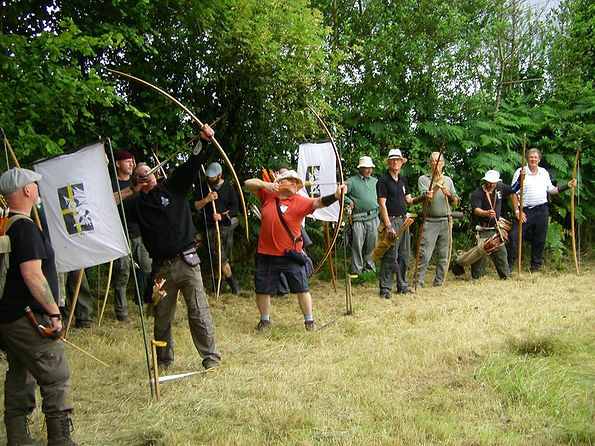
The Lee Cup
The Lee Cup takes place during a rove at Westwood. It is shot with a with a Lyverye Arrowe from your roving bow and awarded for the best distance over 220. The name of the archer, date and distance will be recorded on the Cup.
